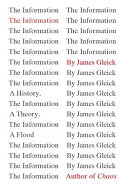

In 'The Information', James Gleick explores the fundamental nature of information, tracing its evolution from ancient communication methods to modern digital technologies. He discusses how information is not merely data but a structured and meaningful representation of knowledge. The book delves into the concept of entropy as it relates to information, drawing on the work of Claude Shannon, the father of information theory. Gleick illustrates how Shannon's groundbreaking theories laid the groundwork for understanding how information can be quantified and transmitted efficiently. He emphasizes that the way information is encoded, stored, and communicated has profound implications for society, culture, and technology. This exploration of the essence of information sets the stage for understanding its pivotal role in shaping human experience and the modern world.
Continue readingGleick takes readers on a journey through the history of communication, from the earliest forms of language and writing to the development of the printing press and the telegraph. He highlights key milestones in the evolution of communication technologies and how each advancement transformed the way information is shared and consumed. The invention of the printing press, for instance, democratized knowledge and led to the spread of literacy, while the telegraph revolutionized long-distance communication, shrinking the world in unprecedented ways. Each technological leap brought about changes in social structures and cultural practices, illustrating the interconnectedness of information and human progress. This historical perspective underscores the idea that communication is not static; it is a dynamic process that continuously evolves alongside technological advancements.
Continue readingAt the heart of 'The Information' is a deep dive into information theory, particularly the contributions of Claude Shannon. Gleick explains how Shannon's mathematical framework for understanding communication laid the foundation for the digital age. By introducing concepts like entropy, redundancy, and the capacity of communication channels, Shannon provided a scientific basis for analyzing how information is transmitted and processed. Gleick discusses the implications of information theory for various fields, including computer science, telecommunications, and even biology. The principles of information theory have influenced everything from the design of efficient algorithms to the understanding of genetic coding. This exploration of information theory not only highlights its significance in technology but also reveals its philosophical implications regarding the nature of knowledge and understanding.
Continue readingGleick examines the profound impact of information on society, culture, and individual lives. He discusses how the proliferation of information, particularly in the digital age, has transformed the way people interact, learn, and perceive the world. The rise of the internet and social media has created an environment where information is abundant and instantaneous, leading to both opportunities and challenges. Gleick addresses issues such as information overload, the spread of misinformation, and the implications of surveillance in an information-rich society. He emphasizes the importance of critical thinking and media literacy in navigating this landscape, as individuals must discern credible information from noise. This exploration of the societal implications of information underscores the need for a nuanced understanding of how information shapes human experience.
Continue readingThe relationship between information and technology is a central theme in Gleick's work. He discusses how advancements in technology have continuously reshaped the ways information is created, stored, and shared. From the invention of the printing press to the rise of the internet, each technological innovation has altered the information landscape. Gleick highlights the role of computers and algorithms in processing vast amounts of data, leading to the emergence of big data and artificial intelligence. He also explores the ethical implications of these technologies, including privacy concerns and the potential for algorithmic bias. By examining the interplay between information and technology, Gleick encourages readers to reflect on the responsibilities that come with the power of information in the digital age.
Continue readingGleick posits that information is not only a human construct but also a fundamental aspect of the universe itself. He draws parallels between information theory and concepts in physics, suggesting that information plays a crucial role in understanding complex systems, from biological organisms to the cosmos. This idea extends to the notion that the universe can be viewed through the lens of information, with patterns and structures emerging from the interplay of data and entropy. Gleick's exploration of this connection invites readers to consider the philosophical implications of information as a universal language, bridging the gap between science, philosophy, and human experience. This perspective encourages a deeper appreciation of the role of information in shaping our understanding of reality.
Continue readingIn the concluding sections of 'The Information', Gleick speculates on the future of information in an increasingly interconnected and data-driven world. He discusses the potential consequences of advancements in artificial intelligence, machine learning, and the Internet of Things. As information becomes more automated and algorithm-driven, questions arise about the implications for privacy, security, and human agency. Gleick emphasizes the need for ethical considerations in the development of information technologies and the importance of fostering a culture of responsibility in handling information. He encourages readers to be proactive in shaping the future of information, advocating for transparency, accountability, and a commitment to using information as a force for good. This forward-looking perspective serves as a call to action for individuals and society to engage thoughtfully with the evolving landscape of information.
Continue reading